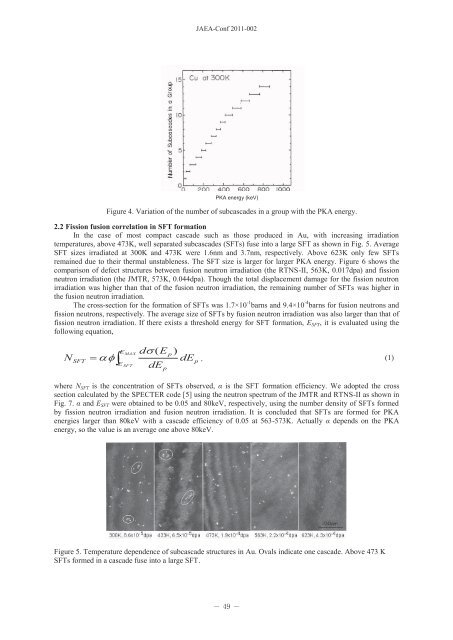JAEA-Conf 2011-002 - 日本原子力研究開発機構
JAEA-Conf 2011-002 - 日本原子力研究開発機構
JAEA-Conf 2011-002 - 日本原子力研究開発機構
Create successful ePaper yourself
Turn your PDF publications into a flip-book with our unique Google optimized e-Paper software.
In the case of most compact cascade such as those produced in Au, with increasing irradiation<br />
temperatures, above 473K, well separated subcascades (SFTs) fuse into a large SFT as shown in Fig. 5. Average<br />
SFT sizes irradiated at 300K and 473K were 1.6nm and 3.7nm, respectively. Above 623K only few SFTs<br />
remained due to their thermal unstableness. The SFT size is larger for larger PKA energy. Figure 6 shows the<br />
comparison of defect structures between fusion neutron irradiation (the RTNS-II, 563K, 0.017dpa) and fission<br />
neutron irradiation (the JMTR, 573K, 0.044dpa). Though the total displacement damage for the fission neutron<br />
irradiation was higher than that of the fusion neutron irradiation, the remaining number of SFTs was higher in<br />
the fusion neutron irradiation.<br />
The cross-section for the formation of SFTs was 1.7×10 -1 barns and 9.4×10 -4 barns for fusion neutrons and<br />
fission neutrons, respectively. The average size of SFTs by fusion neutron irradiation was also larger than that of<br />
fission neutron irradiation. If there exists a threshold energy for SFT formation, ESFT, it is evaluated using the<br />
following equation,<br />
N<br />
SFT<br />
<br />
<br />
E<br />
d<br />
( E<br />
MAX<br />
dEp<br />
, (1)<br />
E SFT<br />
dE<br />
p<br />
p<br />
)<br />
<strong>JAEA</strong>-<strong>Conf</strong> <strong>2011</strong>-<strong>002</strong><br />
PKA energy (keV)<br />
Figure 4. Variation of the number of subcascades in a group with the PKA energy.<br />
where NSFT is the concentration of SFTs observed, α is the SFT formation efficiency. We adopted the cross<br />
section calculated by the SPECTER code [5] using the neutron spectrum of the JMTR and RTNS-II as shown in<br />
Fig. 7. α and ESFT were obtained to be 0.05 and 80keV, respectively, using the number density of SFTs formed<br />
by fission neutron irradiation and fusion neutron irradiation. It is concluded that SFTs are formed for PKA<br />
energies larger than 80keV with a cascade efficiency of 0.05 at 563-573K. Actually α depends on the PKA<br />
energy, so the value is an average one above 80keV.<br />
Figure 5. Temperature dependence of subcascade structures in Au. Ovals indicate one cascade. Above 473 K<br />
SFTs formed in a cascade fuse into a large SFT.

















